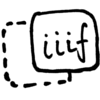
(no
canvas setting)
See also notes on proposed drag and drop pattern.
Imagine the following icon embedded in http://www.e-codices.unifr.ch/en/searchresult/list/one/kba/0003. The icon is linked to a page which might explain the use of the IIIF drag-and-drop icon, the data used when the icon is dragged to an IIIF viewer is encoded as dummy query parameters:
manifest - URI of the manifestcanvas - canvas id of the canvas to focus on (optional)

(canvas = .../kba-0003_002r.json)
Imagine the following icon embedded in a splash page for the Van Gogh's "Self-Portrait Dedicated to Paul Gauguin" image. The icon is linked to a page which might explain the use of the IIIF drag-and-drop icon, the data used when the icon is dragged to an IIIF viewer is encoded as a dummy query parameter:
image - URI of the IIIF Image API info.jsonWhat should happen if a URI is pasted into an IIIF application? One option would be to look at the content, see whether it is a URI, and if so then see whether it resolves to a manifest or an image information document. Test URIs:
http://www.e-codices.unifr.ch/metadata/iiif/kba-0003/manifest.json - manifest for e-codices example above.https://images.harvardx.harvard.edu/ids/iiif/43182083/info.json - image information for Van Gogh self-portrait (from HarvardX).https://www.wdl.org/media/iiif/1,1,1/info.json - image information for Lincoln at Antietam (from World Digital Library).